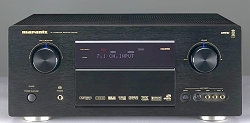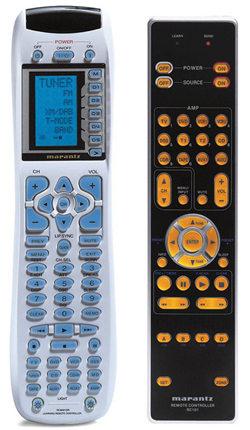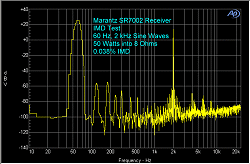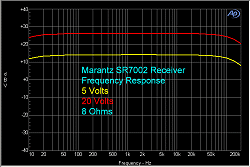Introduction
So I admit it . . . for years I’ve been a fan of Yamaha’s receivers and DSP series integrated amplifiers. Over the years the Yamaha RX-V2090, DSP-A3090 and DSP-A1 have been the center pieces of my home theater. In fact, I’ve been quite happy with the DSP-A1 for the past 9 or so years and have been content to simply sit back and enjoy its performance …well content enough with the DSP-A1. My speakers, amps, DVDs, etc. were still fair game. My satisfaction level dropped precipitously once HDTV and Blu-ray entered my life. Since then, I’ve really had the itch to try out one of the new wiz-bang receivers with HDMI, high def audio, auto configuration etc. Luckily, at least for my bank account, the Marantz 7002 recently showed up at my door to help scratch my upgrade itch.
Specifications
- Design: 7.1 Receiver
- Power: 110 Watts RMS x 7 Channels; All Discrete Amplifier Stage
- Codecs: All Dolby and DTS, including Dolby TrueHD and dts-HD Master Audio
- THX Select2 Certified
- HDMI v1.3a Repeating/Switching: 4-In/2-Out; Component, S-Video, Composite
- Audyssey MultEQ
- Dimensions: 7.25″ H x 17.3″ W x 15.6″ D
- Weight: 33.1 Pounds
- MSRP $1399.99 USA
- Marantz
The Marantz is in the same price class as my former top of the line DSP-A1 and it shows by radiating a solidity you don’t’ get from the lower tier receivers. It’s brushed metal face, solid binding posts and plethora of A/V jacks make you feel that you’re getting something worthwhile for your dollar. The 7002, second from the top in the Marantz lineup, offers the typical omnibus of features of today’s top receivers. Heck, four pages in the manual are dedicated to describing them. So today I’ll highlight what I found to be the most noteworthy among those features and give my impressions of the implementation.
Setup
You can’t or at least shouldn’t simply slap in a new piece of audio gear in your theater and expect it to perform at its peak. This goes double for a receiver which is generally considered to be the heart of a system. In the ‘old days’ (like in the late 90’s when I had purchased my last Yamaha) a proper setup could become quite involved and require extra equipment to do the job right (i.e. an SPL meter to set channel levels and adjust a parametric equalizer). The 7002 offers some key features to simplify the life on the installer —- in this case me.
Audio
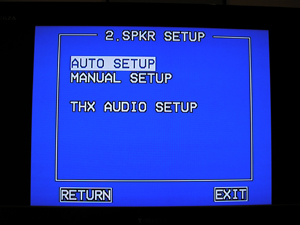 Marantz’s 7002 features the Audyssey MultEQ system to ease the journey to sound nirvana. This system analyzes both your speakers and room to optimize their combined performance. The system is quite easy to use (at least when you run the setup with a monitor attached). Simply connect the provided microphone to a jack on the front of the unit and choose the “Auto Setup†option from the Speaker Setup Menu. The Audyssey MultEQ system takes over from there and clicks and pops like R2-D2 big brother (must be a big brother since it’s louder). After sampling up to 6 spots in your theater speaker sizes, balanced speaker levels (within .5 dB), equalizer settings and distances of the speaker to the listening positions are calculated automatically by Audyssey. Once complete, you’re ready to pop in a movie and enjoy a calibrated theater.
Marantz’s 7002 features the Audyssey MultEQ system to ease the journey to sound nirvana. This system analyzes both your speakers and room to optimize their combined performance. The system is quite easy to use (at least when you run the setup with a monitor attached). Simply connect the provided microphone to a jack on the front of the unit and choose the “Auto Setup†option from the Speaker Setup Menu. The Audyssey MultEQ system takes over from there and clicks and pops like R2-D2 big brother (must be a big brother since it’s louder). After sampling up to 6 spots in your theater speaker sizes, balanced speaker levels (within .5 dB), equalizer settings and distances of the speaker to the listening positions are calculated automatically by Audyssey. Once complete, you’re ready to pop in a movie and enjoy a calibrated theater.
This was my first experience with the Audyssey automatic speaker setup. I was impressed – with a few caveats. Most parameters calculated were spot on accurate when I double checked with a tape measure and my Radio Shack SPL meter. I also found the room-corrected sound, for the lack of a better term, was “light and refreshingâ€. The midrange and upper bass regions were clearer and dialog was more intelligible.
My caveat is regarding the speaker size correction. I was surprised that Audyssey chose to consider all my ERA Design 5 speakers as “Large Speakersâ€. The Design 5 LCR’s I used in this setup are rated down to 50Hz. I found in my previous review (available here on Secrets) that the bass response for the Design 5s began rolling off at 80Hz. I think a better choice would be to limit the bass that these speakers see. The good news is that the Marantz 7002 allows you to correct this easily by tweaking the calculated parameters. For my system’s bass management, I chose a 60Hz High / Low Pass Filter for all my ERA speakers. Allowing the main speakers to focus on the upper bass regions by sending the low frequency information to the sub resulted in a more solid low end. The 7002 offered other filter options as well with settings from 60-180Hz in 20Hz steps.
Since I was already tweaking the Audyssey settings, I took a shot at improving the results calculated for the 9 band Equalizer. After playing around with parameters and listening with and without the equalization, I decided to keep the Audyssey calculated settings due to the superior sound. In fact, I used these settings for all listening tests.
Finally, to touch upon the audio connections available for setup, there are tons. Perhaps the most interesting to me was the ability to bi-amp the main speakers …something that can come in handy with big towers. There are also 8 digital (not counting HDMI), 6 analog, 7.1 channel input and even pre-amp outputs for driving external amplifiers. I think that assortment should satisfy most folks.
Â
Video
The Marantz 7002 offers a feature that would have been a pretty expensive option a few years ago, video up-conversion. I had really looked forward to using this feature. For those of us with a HDTV, all of the cabling to the TV can be reduced to a single HDMI cable. This means older analog devices (DSS, VCR, etc) using composite, s-video, or component connections or digital HDMI sources can be output as either 480i, 480p, or 1080i via either of the two HDMI outputs on the 7002. Dropping the cable count can greatly simplify and de-clutter a setup. Unfortunately, the 7002 does not mention the support of 1080p. Since the HDMI inputs are modern 1.3a version of the HDMI standard, I assume that no video sources are converted to that resolution but HDMI sources of 1080p would be passed through. With the gear I had on hand I did not have the capability to check.
Another nice feature of the Marantz that added to its flexibility was the ability to match the various input jacks to any of the seven sources via a functional input mapping. With input mapping you can ignore the labels for CD, DVD etc on the unit and choose the configuration best suiting your needs. In addition, you could match your intended use by renaming inputs on the display. So what you ask? Here’s what I did. I assigned one the HDMI input 2 and one of the optical input 2 to AUX1. I then connected my PC’s DVI output to the HDMI in on the 7702 and the PC’s optical DTS output to the optical input. Finally, I renamed the source to “HT PCâ€. Now when I want to use my home theater PC, I simply select “HT PC†from the Marantz input select menu. Quite slick.
Audio and Video Performance
The Marantz 7002 has the Select2 stamp of approval from THX which is their guarantee that the receiver will provide a theater like experience for rooms with a viewing distance of 10-12 feet. Based on what I heard, I agree.
Audio
When I evaluated the music capabilities of the 7002, I used both my PS3 as well as my Yamaha CDC-835 via Digital Coax connection. This was mainly so I could test the HDCD decoding capability of the Marantz. If you aren’t already familiar with HDCD, the 20-bit HDCD encoded CDs provide additional information over standard 16 bit Red Book CDs. This extra information can be used by recording engineers to improve the sound of a standard CD for those of use with equipment to decode the information – like the 7002.
Enough background, was there a difference between the 16bit signal and the 20 bit signal? After listening to a few convenient HDCDs including Garth Brooks’ “Sevensâ€, I can definitely report that the Marantz does detect and decode the HDCD information – the little light on the display helps with that. While it wasn’t a night and day difference, the HDCD version of the song was preferable. The sound was a bit cleaner with HDCD with a more three dimensional sound stage. Considering that HDCD is available on many CDs at no extra cost, this is a nice feature of the Marantz.
During my music evaluation, I tried a few of the surround processing modes offered by the 7002 or in the case of the first, the unprocessed mode. The 7002 offers a “Pure Direct†mode that eliminates any processing of the music by the receiver. It dims the display to eliminate any injection of noise to give the purest (of course) signal possible. I found that I preferred the normal mode on the 7002 for my system. The normal modes use of bass management better integrated the sub and the main speakers. Your mileage will vary – especially those of you with full range towers up front.
The Marantz also offers a Dolby Pro Logic 2 and DTS Neo:6 processing to expand 2 channel music into all of your speakers. Even though my preferences typically lean towards a two channel listening experience, I found that the simulated surround offered sounded quite natural and filled the room well. This was especially true using the DTS Neo: 6 Music option.
Video
Originally, I wanted to focus on the high definition audio decoding provided by the 7002 and even purchased a few new Blu-Ray disks to check out its performance. These were “The Incredible Hulk†since it offered a DTS-HD Master Audio and “Indiana Jones and the Kingdom of the Crystal Skull†which offered a Dolby TreuHD soundtrack. Unfortunately, I ran into a problem. I discovered that my Sony PS3 bitstream output cannot transmit either of these formats over the HDMI connection I used (so that the Marantz would decode the signal) – oops! Instead the PS3 internally decodes these surround formats and sends it as a PCM signal to the Marantz. So what you ask? While I was not able to test the internal decode of the Marantz, the uncompressed sound offered by these disks were still incredible. Dialog was clear and the effects were enveloping and engrossing. I particularly enjoyed the new THX intro on Indy as well as the escape from the warehouse in chapter 2. I would have preferred that the Marantz do the heavy lifting on the surround decode. However, in my “every man†setup using a PS3 (likely still the most common Blu-Ray player) as the source these results will probably be relevant to most of you out there.
Also noteworthy, the 7002 offers Dolby Headphone technology. For those late nights when you can’t bother anyone and can live without your sub, this simulated surround processing can give you a theater experience with just your headphones.
Â
Â
The SR7002 Remote Control
The 7002 includes 2 remotes, a simplified second room remote and a universal remote. Like the receiver itself, the RC8001SR universal remote tries to do everything. It includes codes for common components, the ability to learn remote codes, macro capability and a small OSD. I never really became comfortable with the remote during the review period due to the small and hard to read (at least for me – even if backlit) buttons and paged access to functions on the OSD. I think back to the old cryptic 8 in 1 remote from Radio Shack that I learned by touch in the early 90’s. If I owned the 7002 and used this remote daily, I would eventually learn the ins and outs of its operation – just as I did with my ancient Radio Shack remote. However, I would not expect many people to pick it up and use it intuitively. Case in point, Mom scratched her head for a few minutes until I rescued her and turned the volume down.
The RC101 remote provided for the second room had a streamlined look and feel compared to the main remote. However, unless you plan on installing IR repeaters and using the second room option, it isn’t very useful day to day. Mine ended up back in the box.
While not necessarily a hand held remote, the 7002 provides an RS-232 serial input. This allows control of the receiver by and external device. This would be typical in higher-end professional installation with custom automation and control of a theater. The manual also notes that this serial input may be used for future firmware upgrades. It’s nice to see future proofing features.
Other Features
While I doubt that I am covering every feature, the Marantz has some other nice additions. If you have an XM subscription, the Marantz has you covered with its built in support. However, if you want HD-Radio you’ll need to step up to the top of the Marantz line, the 8002.
The 7002 also offers M-Dax (Dynamic Audio Expander) to improve the sound of compressed audio. Surprising, especially considering how widespread they are, the iPod and iPhone were not supported. I played a few MP3 encoded at 192Kbps to test M-Dax and preferred the unprocessed sound.
Finally, the Marantz supports multi room audio and video. The Marantz can directly drive a pair of speakers using its internal amps or it can send both audio and video to an external amplifier and monitor in the second room using composite cables. The provided second room remote can select the desired signal to route to the remote location. Note that you may need some extra hardware such as an IR receiver (available from Marantz) to control this remote operation, well, remotely. Editorially, I never understood multi room audio. Doesn’t everyone have a progression of ‘trickle down’ home theaters? The cool stuff starts in the main theater and eventually works it way out to the garage as the next best thing is obtained. Using multi room interferes may interfere with this ‘natural’ flow!
Ergonomics
Before I dive into specifics, I want to point out that while the Marantz does provide some assistance in setup and tons of features it is, like many feature laden products, a complicated piece of equipment. If my dog-eared manual is any indication, you will be spending time digging through the manual to get the most of the Marantz. The good news is that I found the manual to be clearly written.
On Screen Display (OSD)
One of the main things that bothered me regarding the 7002’s ergonomics was the user interface.Â
Myfirst tip is, before you try to do any sort of setup, connect the receiver to your TV. The small display on the receiver itself provides some help but it is tough to use, compared to the available on screen display (OSD). Referring to the screen capture above, the OSD provided isn’t very pretty or fast, at least compared to today’s top interfaces like the PS3, but it is functional and makes setup easier.
For day to day operations such as choosing a surround mode, selecting sources, or even changing the volume the user feedback is limited to the small display on the receiver itself – no OSD is available via HDMI. Personally, when I am watching my big screen, I don’t want to start squinting at the itty bitty receiver display to change or verify my surround sound choice.
Â
Â
On the Bench
I tested the SR7002 with two channels driven.
At 20 volts output into 8 ohms (50 watts), IMD was 0.038%.
THD+N vs. Frequency showed pretty good performance at both 8 ohms and 4 ohms. This receiver should be able to drive 4 ohm speakers, but just don’t go overboard on the volume control.
With two channels driven, power output into 8 ohms was 140 watts per channel before a sharp rise to clipping (1% THD+N) at 155 watts per channel.
At 4 ohms, distortion began the sharp rise at 175 watts per channel, to clip at 200 watts per channel.
The frequency response was the same at 8 ohms and 4 ohms: 20 Hz – 50 kHz, – 1 dB.
Â
Â
Conclusions
The Marantz SR7002 receiver is worthy of the near “top of the line†position it holds at a well respected manufacturer. It suffers from a few ergonomic faux pas that seem common in today’s complex A/V receivers. However, once those are overcome and it is integrated into your system, the Marantz 7002 offers the features and performance that should serve you well for years to come. Personally, I am willing to work through the ergonomic issues and I am considering replacing my former top of the line Yamaha with the Marantz 7002.



